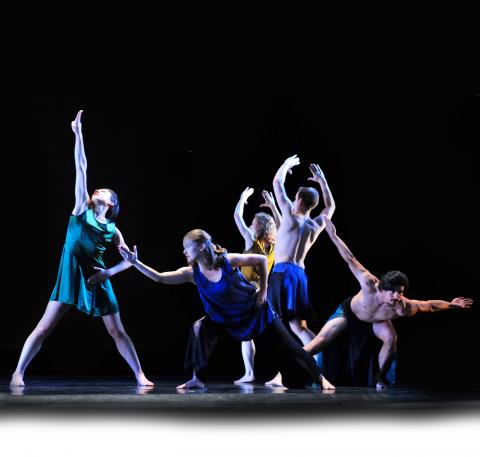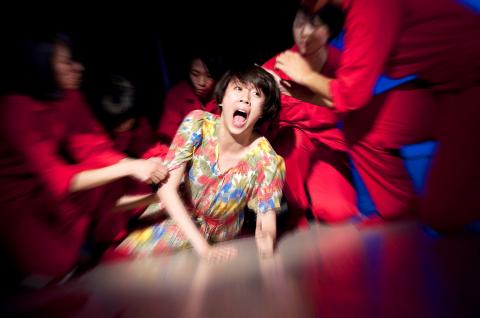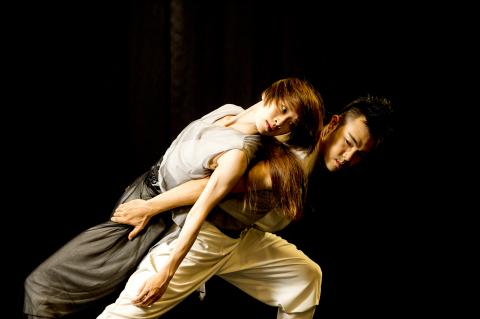This is the kind of weekend that gives dance lovers nightmares about empty wallets. Too much choice, too little time. However, with careful budgeting of schedules and money, it is possible to see all three terrific groups that are performing in Taipei today and tomorrow.
First up is one of the US’ — and the world’s — top contemporary troupes, the Mark Morris Dance Group, which will be making its Taiwan premiere.
The promoter, the Management of New Arts, has brought the troupe and its music ensemble to Taiwan for performances in Taipei as well as at the Tainan Arts Festival in Greater Tainan. It is quite a coup, because the company is one of the best modern troupes in the world and Morris himself has helped redefine both ballet and contemporary dance as few of his contemporaries have. It is hard to understand why it has taken this long to get the company here.

Photo: Mandy Cheng, AFP
It is hard to believe the Brooklyn, New York-based troupe is now 34 years old and its founder is 58; it seems just yesterday that one could not read about Morris without seeing the words “enfant terrible of dance” somewhere close by.
Morris, who performed with companies as diverse as Lars Lubovitch and Eliot Feld before branching off on his own, has blossomed into a renaissance man in recent decades. In addition to creating ballets for companies worldwide and working for many years with Mikhail Baryshnikov on the White Oak Project, he has added conducting to his list of achievements as well as directing and choreographing operas.
The company has brought two separate programs, A and B, each featuring three works, that give a broad overview of Morris’ style and technique. Program A (Eleven, Double and Grand Duo) was performed on Thursday and Friday in Taipei and will be seen again in Greater Tainan on Thursday night.

Photo courtesy of Liu Ren-haur / Scarecrow Contemporary Dance Company
Tonight and tomorrow sees program B at the National Theater, to be repeated on Friday in Greater Tainan: All Fours, Crosswalk and Festival Dance.
All Fours, from 2003, is set to Bela Bartok’s String Quartet No. 4 in C Major, Op. 91. The almost brand-new group piece Crosswalk, which premiered last year with all its clashes and interminglings, is set to Carl Maria von Weber’s Grand Duo Concertant, for Clarinet and Piano, Op. 48, while Festival Dance, from 2011, set to Johann Nepomuk Hummel’s Piano Trio No. 5 in E Major, Op. 83.
There are still tickets left in several price categories for tonight and tomorrow’s show in Taipei and the two in Greater Tainan. They are pricey — but well worth it.

Photo courtesy of Jade & Artists Dance Troupe
Meanwhile, upstairs in the National Theater complex, the Greater Tainan-based Scarecrow Contemporary Dance Company (稻草人現代舞蹈團) is performing its latest production, Singular (單‧身) in the Experimental Theater.
The company, which is marking its 25th anniversary this year, is going strong under the leadership of choreographer Luo Wen-jinn (羅文瑾), who became artistic director in 1998.
Scarecrow is known for producing thought-provoking works — by Luo and others — that continue to raise questions in the audience’s minds long after they have left the theater.
Luo’s own works are based on astute observations of modern society and life in Taiwan, often centered on the conflicts between individuals and family, solitude and urban life, the impact mental stress can have on the physical.
The company says the latest work was inspired by Paul Auster's book, The Invention of Solitude, as well as the tenuous space that exists between reality and nonentity and the eternal question of existence. Set on eight dancers, Singular is an exploration of eight stages of life as seen by a lonely woman, an outsider, an abandoned love child, a forlorn mother.
Across town at the Metropolitan Hall, the Shilin-based Jade & Artists Dance Troupe is performing the third chapter of its “Catch of the Glimpses” program, Action Without Action (捕風捉影Ⅲ─無為).
This is the third installment of series that began with Catch of the Glimpses in 2004, an exploration of martial art as well as traditional Chinese and contemporary dance movements.
For Action Without Action, the group’s artistic director and choreographer, Jade Hsu (華碧玉), invited Lin Hui-kuan (林慧寬), a pipa (琵琶) player from Chai Found Music Workshop (采風樂坊) and drummers from Mobius Strip Theatre (莫比斯圓環創作公社) to perform with her troupe.
Hsu turned to the central tenets of Taoism for inspiration for her latest work, the idea of doing without trying to do. The dance is a dialogue between tradition and modernity, using the tension and repose of modern dance and martial arts to interpret Laozi (老子), the founder of Taoism, philosophy.
The show runs 90 minutes, including a 15-minute intermission.
This story has been corrected since it was first published.
Dance Notes
WHAT: Mark Morris Dance Group
WHEN: Tonight at 7:30pm, tomorrow at 3:30pm
WHERE: National Theater (國家戲劇院), 21-1 Zhongshan S Rd, Taipei City (台北市中山南路21-1號)
ADMISSION: NT$1,200 TO NT$3,600; available at ERA ticketing booths, online at www.ticketing.com.tw and at 7-Eleven ibon kiosks and other convenience store ticket kiosks
ADDITIONAL PERFORMANCES: As part of the Tainan Arts Festival, the company will be performing Program A on Thursday, June 19, and Program B on Friday, June 20, at the Tainan Municipal Cultural Center (臺南文化中心演藝廳), 332, Chunghua East Rd Sec 3, Greater Tainan (臺南市中華東路3段332號); tickets priced and available as above.
WHAT: Action Without Action
WHEN: Today at 7:30pm, tomorrow at 2:30pm
WHERE: Metropolitan Hall (城市舞台), 25, Bade Rd Sec 3, Taipei City (台北市八德路三段 25號)
ADMISSION: NT$400 to NT$2,500; available at door, NTCH box offices, online at www.artsticket.com.tw and at 7-Eleven ibon and other convenience store kiosks
WHAT: Singular
WHEN: Today at 2:30pm and 7:30pm, tomorrow at 2:30pm
WHERE: Experimental Theater (國家實驗劇場), 21-1 Zhongshan S Rd, Taipei City (台北市中山南路21-1號)
ADMISSION: Tickets are NT$500, available at NTCH box office, online at www.artsticket.com and at 7-Eleven ibon and other convenience store kiosks

That US assistance was a model for Taiwan’s spectacular development success was early recognized by policymakers and analysts. In a report to the US Congress for the fiscal year 1962, former President John F. Kennedy noted Taiwan’s “rapid economic growth,” was “producing a substantial net gain in living.” Kennedy had a stake in Taiwan’s achievements and the US’ official development assistance (ODA) in general: In September 1961, his entreaty to make the 1960s a “decade of development,” and an accompanying proposal for dedicated legislation to this end, had been formalized by congressional passage of the Foreign Assistance Act. Two

Despite the intense sunshine, we were hardly breaking a sweat as we cruised along the flat, dedicated bike lane, well protected from the heat by a canopy of trees. The electric assist on the bikes likely made a difference, too. Far removed from the bustle and noise of the Taichung traffic, we admired the serene rural scenery, making our way over rivers, alongside rice paddies and through pear orchards. Our route for the day covered two bike paths that connect in Fengyuan District (豐原) and are best done together. The Hou-Feng Bike Path (后豐鐵馬道) runs southward from Houli District (后里) while the

March 31 to April 6 On May 13, 1950, National Taiwan University Hospital otolaryngologist Su You-peng (蘇友鵬) was summoned to the director’s office. He thought someone had complained about him practicing the violin at night, but when he entered the room, he knew something was terribly wrong. He saw several burly men who appeared to be government secret agents, and three other resident doctors: internist Hsu Chiang (許強), dermatologist Hu Pao-chen (胡寶珍) and ophthalmologist Hu Hsin-lin (胡鑫麟). They were handcuffed, herded onto two jeeps and taken to the Secrecy Bureau (保密局) for questioning. Su was still in his doctor’s robes at

Mirror mirror on the wall, what’s the fairest Disney live-action remake of them all? Wait, mirror. Hold on a second. Maybe choosing from the likes of Alice in Wonderland (2010), Mulan (2020) and The Lion King (2019) isn’t such a good idea. Mirror, on second thought, what’s on Netflix? Even the most devoted fans would have to acknowledge that these have not been the most illustrious illustrations of Disney magic. At their best (Pete’s Dragon? Cinderella?) they breathe life into old classics that could use a little updating. At their worst, well, blue Will Smith. Given the rapacious rate of remakes in modern